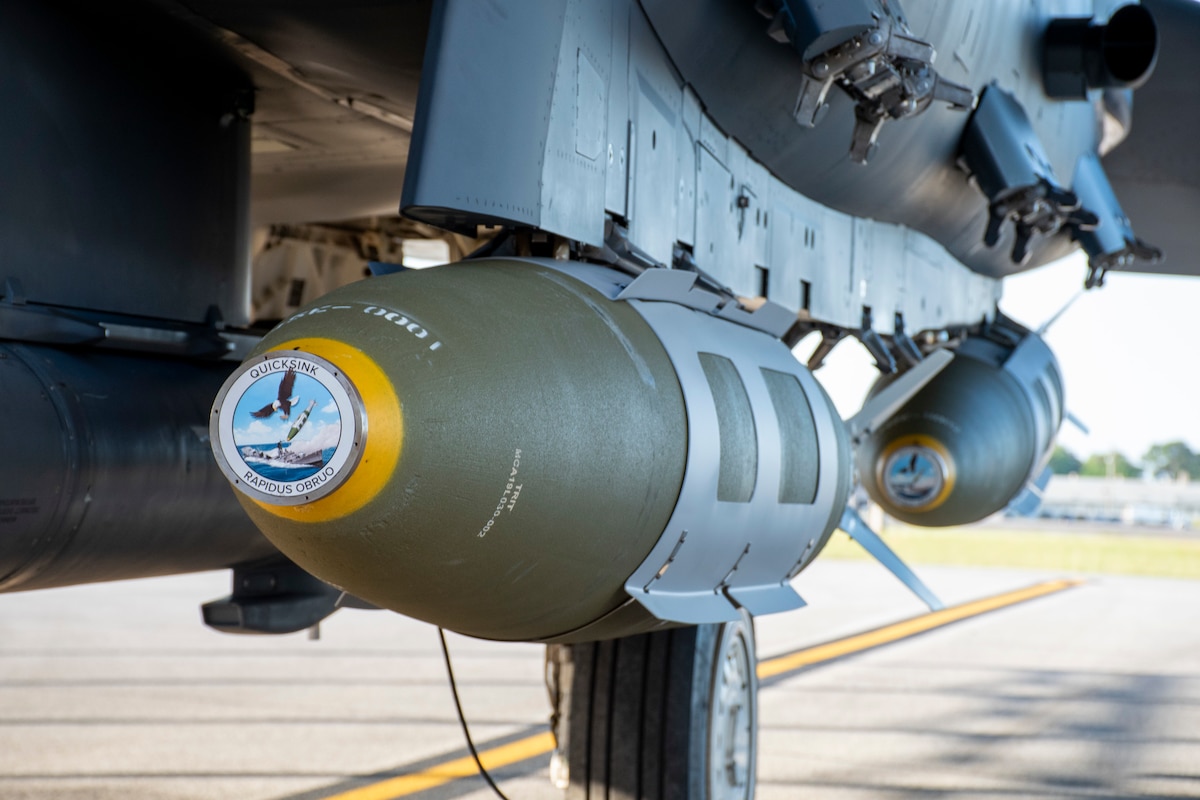The US Air Force Research Laboratory (AFRL) announced the successful firing trials of its new air-launched maritime strike experiment, known as ‘Quicksink’, which for the first time, destroyed a full-scale surface vessel in the Gulf of Mexico.
“Nuking” London & Paris – Russian State-TV Threatens To Annihilate European Cities Using ‘Mighty’ Sarmat Missiles
The Quicksink Joint Capability Technology Demonstration (JCTD) is an experiment aimed at providing a low-cost anti-ship capability that could achieve torpedo-like seaworthy kills. This is because, while a single submarine-launched torpedo can destroy an entire ship, it also gives away the location of the submarine.
The experiment involves the use of a 2,000-pound class GBU-31 Joint Direct Attack Munition (JDAM) modified to engage a moving target. Standard JDAMs have a GPS-assisted Interial Navigation System (INS) guidance system that can only be used to point them at specific coordinates.
The single modified JDAM was launched from an F-15E Strike Eagle fighter on April 28 as part of a collaborative effort between AFRL, Eglin’s Integrated Test Team, the 780th Test Squadron of the 96th Test Wing, and the 85th Test and Evaluation Squadron of the 53rd Wing.

The objective of the latest JCTD included assessing the feasibility of bringing the Quicksink concept into operational use.
“Quicksink is an answer to an urgent need to neutralize maritime threats to freedom around the world,” said Col. Tony Meeks, director of AFRL’s Munitions Directorate.
JDAM For Hitting Surface Naval Targets
The US Air Force (USAF) wants to repurpose the JDAM for the maritime strike capability to field it against stationary or moving targets without spending too much money.
To accomplish this, the Quicksink program relies on the weapon open systems architecture (WOSA), a seeker for the JADM, which allows ‘plug & play’ capabilities for several different seeker components, thereby reducing the weapon system costs and enhancing the performance.
“Quicksink is unique in that it can provide new capabilities to existing and future DOD weapons systems, giving combatant commanders and our national leaders new ways to defend against maritime threats,” explained Kirk Herzog, AFRL program manager.
While there are a host of precision-guided munitions and air to surface missiles to hit the naval surface targets but nothing as effective as the heavyweight torpedoes such as the Mk 48, which can destroy large vessels, and Quicksink precisely seeks to fill this gap.

“A Navy submarine has the ability to launch and destroy a ship with a single torpedo at any time, but the Quicksink JCTD aims to develop a low-cost method of achieving torpedo-like kills from the air at a much higher rate and over a much larger area,” continued Herzog.
Guidance System
What remains unclear, though, is exactly what kind of guidance kit is fitted to the modified JDAM, adding a capability to hit moving targets.
There is an AFRL video depicting a Quicksink weapon fired by an F-35 against a container vessel armed with a covert missile launcher.
The video shows the launching F-35 receiving targeting data from a P-8 Poseidon maritime patrol aircraft, following which the F-35 pilot launches the weapon after uploading the targeting data into it.
The weapon then flies to the estimated vicinity of the target after which it activates its ‘all-weather maritime seeker’ to search for the target autonomously and locks onto it to attack the target.
Meanwhile, reports have suggested the use of a multi-mode guidance system combining millimeter-wave radar and an imagining infrared seeker, similar to that used in the GBU-53/B StormBreaker.
While another guidance option could involve a datalink.
In this method, the target would be tracked by an offboard sensor, such as an aircraft’s radar, and the targeting telemetry would be continuously fed to the JDAM after release which could then be combined with the JDAM’s existing GPS-assisted inertial navigation system (INS) guidance package, which operates much like an autopilot so that it finds its way to the moving target.
Small Range Could Be A Limitation
One of the limitations of Quicksink would be its range. The basic JDAM has a range of about 15 miles (24.14 km), which is deep within most major naval anti-air threat rings and is vulnerable to naval close-in air defense systems. So, it will probably not be very effective against high-priority targets requiring a more sophisticated solution.
Nevertheless, modified JDAM can certainly offer the USAF a viable low-cost anti-ship solution as the service has a large stockpile of these weapons and the availability of a maritime kit should allow existing weapons to be fairly rapidly configured for this new role.
As the US military prepares for a potential conflict with near-peer adversaries such as Russia and China in particular, having a big stockpile of anti-ship weapons that can be launched from the air will certainly be instrumental in dominating the opponent in a high-end maritime centric battle.
- Written by Tanmay Kadam/EurAsian Times Desk
- Contact the author at etdesk@eurasiantimes.com
- Follow EurAsian Times on Google News




